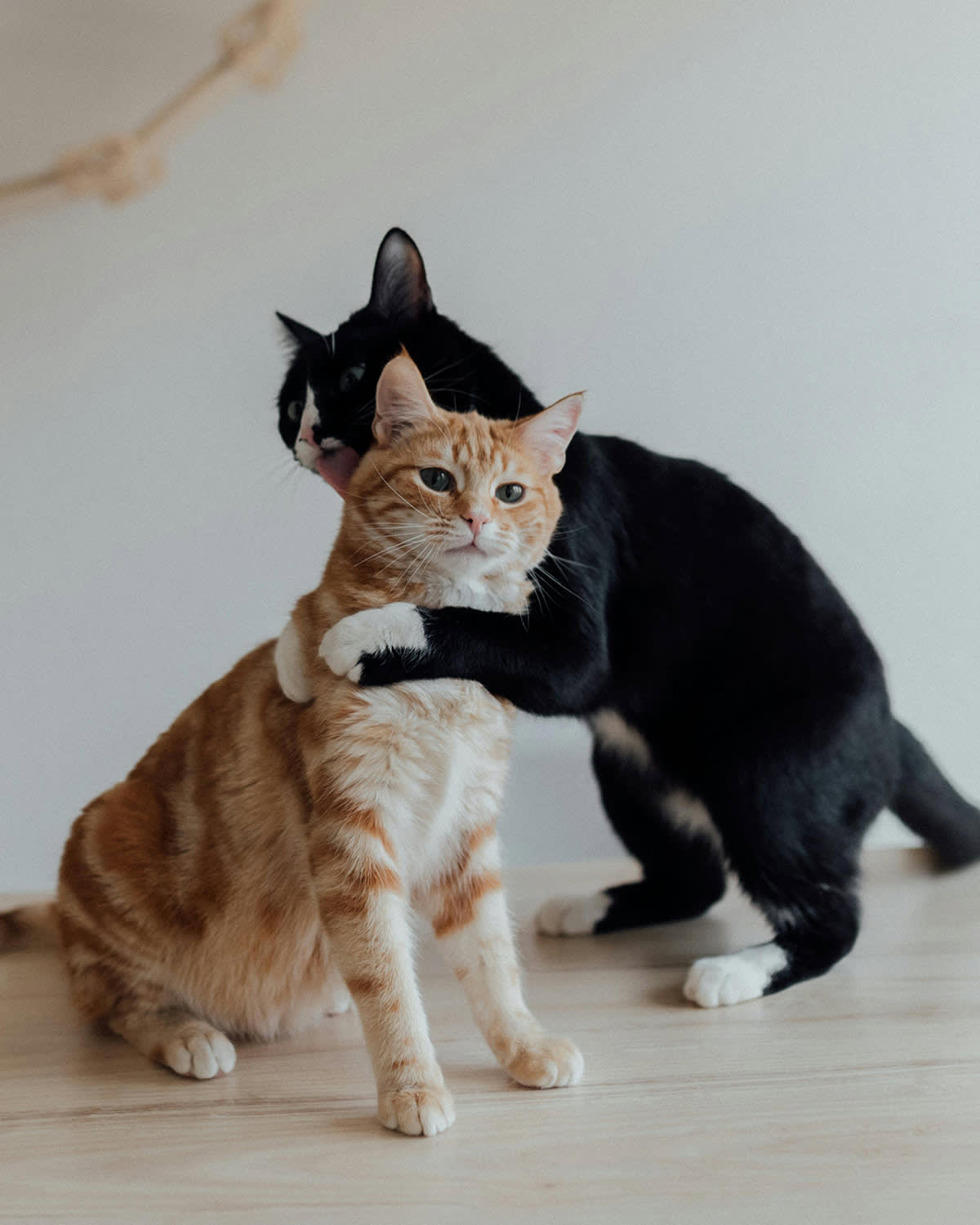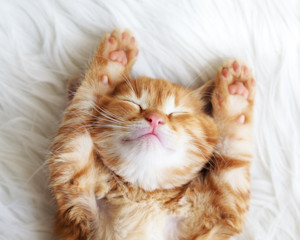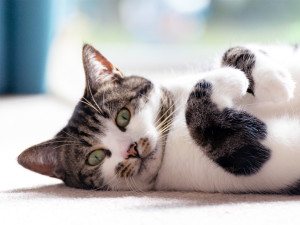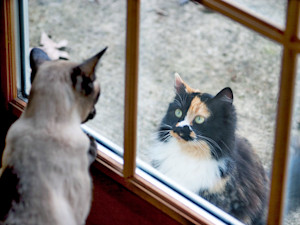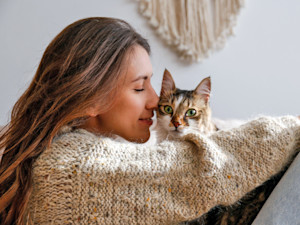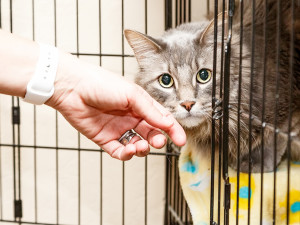Is the ‘Mean Girl’ Cat Stereotype Hurting Female Cats?
TikTok loves boy cats, but all felines need affection
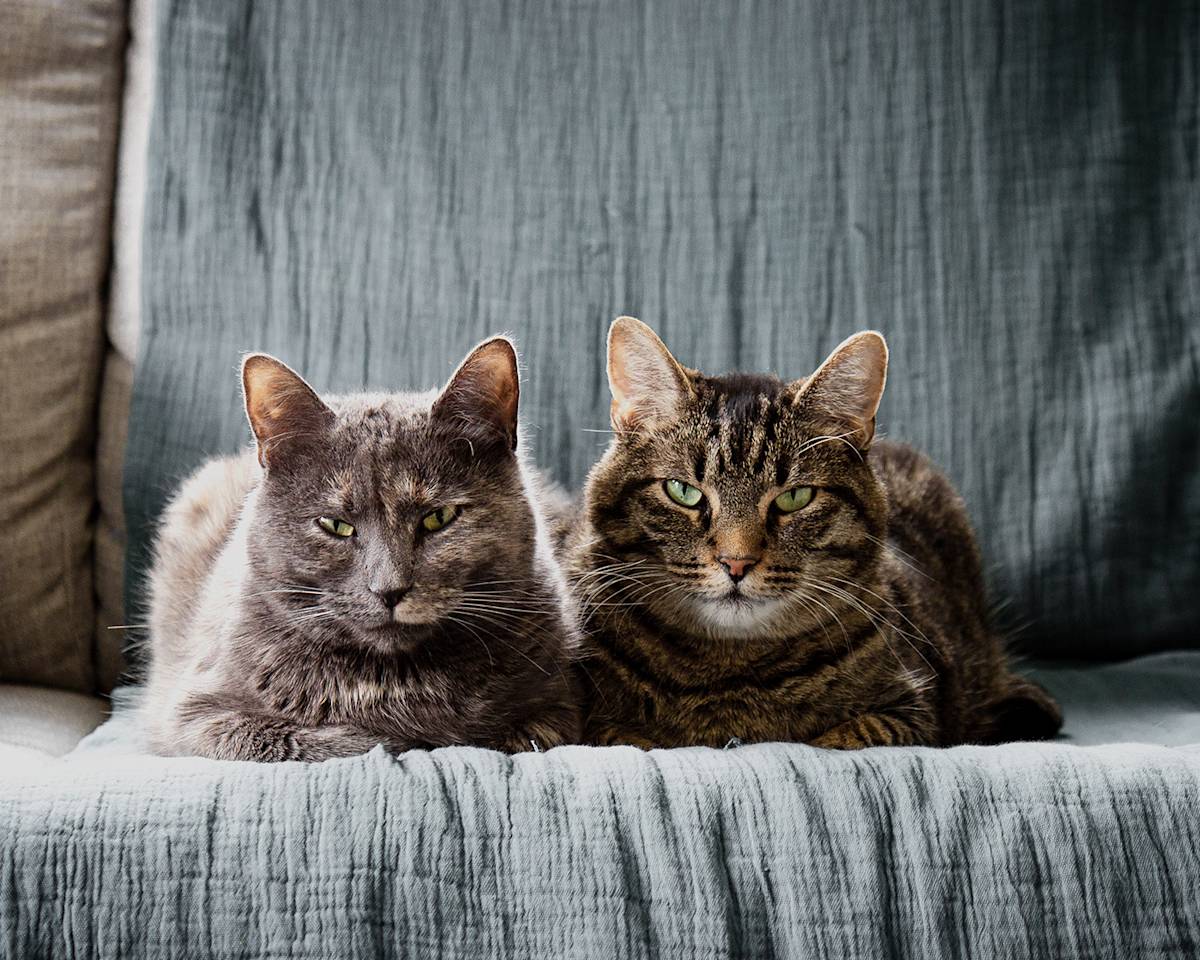
Share Article
If you’re on the feline side of TikTok, you might have noticed a battle of male vs female cats, all related to their personality. You may have seen people comparing their cats, joking that ‘boy cats’ are goofy, affectionate and eager to please, whereas ‘girl cats’ are more aloof and judgmental.
The most popularopens in new tab of theseopens in new tab videosopens in new tab are getting over a million views and hundreds of thousands of likes. They’re not intended to be taken seriously, of course. But, if people are exposed to this kind of bias, could it affect adoption rates? And can these stereotypes be backed by science?
Ultimately, sex is one factor of many. Age, breed and the length of time a cat has been living in a home all influence their behaviour and personality. We spoke to vets and behaviourists to separate fact from fiction – things aren’t as simple as you might expect.
What TikTok gets wrong (and right) about cats
The viral videos usually begin by showing a male cat being silly and affectionate paired with a wholesome audio clip before switching to a female cat. Often, the audio changes to a female voice giving an insult, suggesting that they aren’t as friendly and loving.
Similarly, you may have heard people talk about their boy cats being more cuddly or their girl cats being more independent. And honestly, there might be a degree of anecdotal truth there.
However, one study from 2023opens in new tab indicates that pet parent perception plays a big part in analysing cat to human affection. People with male cats were more likely to view their relationship with them as positive and report higher levels of friendliness. However, authors of the study noted that male cats generally tend to have a higher activity level than female cats, which could attribute to the behavioural patterns associated with cats’ sex. Behaviourists also theorised that any of the (self-reported) behavioural patterns could be based on preconceived ideas around gender roles in the pet parent.
The science: do male and female cats have different personalities?
There isn’t a lot of research that looks into the personalities of male and female cats specifically, aside from anecdotal evidence and a handful of studies – other factors play a much larger role.
One study looked at cats living with childrenopens in new tab, and found that female cats scored higher on the ‘fearfulness/aggression’ metric. Conflictingly, another studyopens in new tab (albeit from 1999), found that there was no significant difference between male and female neutered cats.
Indeed, where you’ll probably see the biggest differences is between cats who haven’t been spayed or neutered, as their hormones play a much larger role in influencing their behaviour – this paperopens in new tab highlights aggression as being most common among intact males. Expert vet Dr Scott Milleropens in new tab explains that intact male cats are more likely to stray further to find a mate, spray indoors to mark territory, and be more aggressive with other cats.
In contrast, he says that female cats can be irritable, overly affectionate or just out of sorts when in season. They can be more vocal, too, and might yowl or cry. They tend to go into heat when it’s warmer and the days are longer, so usually from around February to October in the UK.
“But when sex-specific hormones, testosterone and oestrogen, are removed at desexing, these stimulants decline to negligible levels, leaving just the personality traits of each individual to shine through” Dr Miller explains.
Sadie Spencer, leading emergency vet at Vets Nowopens in new tab, adds: “If you want a calm, friendly companion, the best approach is to get them used to many different people and things from an early age and follow your vet's recommendations on neutering.”
Why we think male cats are different
One way in which male cats are physically different from females is their facial features. They often have rounder heads with chubby cheeks – though these differences aren’t quite so prominent in male cats who are neutered at a younger age.
As humans we’re programmed to find certain facial and body features cute. The ethologist Konrad Lorenz coined the concept of ‘baby schema’ in 1943. He described it as a set of infantile features, like a large head, big eyes and a round face, which trigger a feeling of ‘cuteness’ and an innate drive in adults to care for the infant. It’s why people think babies are cute, and it explains why we love kittens, puppies and other young animals.
Because male cats are more likely to have some of these features, we might see them as cuter even without realising. In turn, this might affect the way we perceive their personality.
Likewise, could there be a connection with the ‘bouba/kiki’ effect? This phenomenon is a mental association people have between certain sounds and shapes. Some made-up words like ‘bouba’ are associated with a rounded shape, while others, like ‘kiki’, are associated with a spiky shape. With their rounded faces, do we consider boy cats to be ‘bouba’, and by extension consider girl cats to be ‘kiki’?
These associations with male cats’ features and our ideas of traditional gender roles could be causing us to fall into a confirmation bias trap. When we see a male cat with a personality that fits our preconceived ideas, it reinforces our way of thinking, and our brains ignore the times they may not.
Are female cats actually less friendly?
When it comes to popular feline stereotypes, male cats get quite a good deal. Female cats, on the other hand, would have the right to feel somewhat aggrieved. While males are seen as kind and affectionate – if not the most intelligent – female cats are stereotyped as aloof and unkind.
But this assumption doesn’t hold up to scrutiny. A male and a female cat alike can have an incredibly affectionate and loving personality, and if you’re bringing a cat into your life, you shouldn’t adjust the care and attention you give them based on their sex.
Popular TikTok cats like Pyaariopens in new tab and Monaopens in new tab, and the cat in this TikTok videoopens in new tab, which directly addresses the stereotypes, are great examples. The boy cat trend would have us believe that female cats don’t act like this, when it’s evident they do.
Sure, the boy cat trend might be in good humour, but it could have harmful consequences. Imagine a female cat who’s more withdrawn or aloof because she’s in pain and needs treatment, but it’s written off as typical ‘girl cat’ behaviour. Or someone who perceives their female cat to be more distant in personality might then engage less with her, creating a self-fulfilling prophecy.
More seriously, this 2014 studyopens in new tab found that male cats at a no-kill shelter in New York had shorter stays before getting adopted than female cats. Of course, there could be multiple reasons for this, but stereotypes about male and female cats could certainly be a factor.
We should help all cats feel secure. You can do so by providing them with a regular routine, places to hide and climb, and quiet locations for their food, water and litter, while also ensuring that you’re calm and gentle with them.
What factors actually affect cat personality?
Granted, a cat’s sex may influence their personality to an extent. But every cat is an individual and it’s simply not possible to determine whether a male or female cat is ‘better’. Put two male cats side by side and there’s no guarantee they’ll have even remotely similar personalities. Other factors, such as breed and living environment, play a much bigger role.
As clinical animal behaviourist Amanda Campionopens in new tab explains, “Some breeds are selectively bred for traits like sociability (Ragdolls) or independence (Russian Blues).” And, in some breeds – including larger cats like Maine Coons – there’s a more noticeable difference between male and female animals, with the males having features like a larger head and more pronounced cheeks.
Age can’t be discounted either. Kittens can often be bolder and more playful, while adult cats begin to find comfort in routines, and seniors might be quieter and calmer.
And a cat’s life experience will have a huge impact, too. If they had a traumatic early life – perhaps they lived on the street as a kitten – they might be more defensive or display fear-based behaviour. In contrast, if they experienced a stable early life with plenty of love and affection, they’re probably going to be more affectionate and at ease.
Ultimately, says Campion, “Early socialisation is the most significant factor in shaping a cat’s temperament. Kittens that are gently handled and exposed to people, other animals and new environments during the sensitive period (2–7 weeks) tend to develop into more confident and sociable adults.”
Male or female: which cat should you choose?
If you’re thinking of adopting a cat, you might be considering both male and female cats. If you’re hoping for an affectionate cat, male cats might be on your radar. Or vice-versa, if you’d rather a more independent feline.
But choosing a cat based on sex is no guarantee that you’ll get a pet with the personality you’re after. It’s all down to the individual cat rather than one sex being a better fit than the other.
If you’re thinking of choosing a rescue cat, get in touch with rescue centres in your area. Often, you can view cats online before making a visit in person, and this might give you a good idea of the right cat for you.
At the rescue centre, spend time meeting the cats you’re interested in and observing their behaviour. Don’t be afraid to ask staff or volunteers about them, too – they’ll be only too happy to help the cats find their forever homes.
You could ask about the cats’ previous experiences, interactions with other cats, dietary preferences and litter box habits – there’s so much to find out before even thinking about whether they’re male or female.
Certified cat behaviourist Lucy Hoileopens in new tab says that if a cat doesn’t have that all-important early socialisation or has negative early experiences with humans, “They can struggle to live around people at all, and prefer a life away from humans such as on a farm. It is often possible to bond with these cats, but it takes a lot of time and they will always be wary and untrusting of new people.”
And don’t forget, the differences between male and female cats are a lot less noticeable when cats are neutered. There are many important reasons to do so, from removing the risk of unwanted pregnancy to reducing the chance of your cat developing certain cancers – it’s part of being a responsible cat parent.
Males and females in multi-cat households
Bonded pairs (or groups) of any make-up can get along – it mainly comes down to temperament. Campion uses the example of a confident, playful cat who might overwhelm a shy cat, regardless of what sex they both are, and suggests that age and energy levels are more accurate predictors of success.
“Neutered males and spayed females can coexist peacefully in any combination if introductions are done correctly,” she says, emphasising the importance of proper introductions, with scent-swapping and slow acclimation.
“Sex is not something I would think too much about when choosing pairs,” adds Hoile. “Temperament and personality are much better indicators of whether they are going to get along.”
“Caregivers must be cat-led during this process, and everything should be done at the cats’ pace,” advises Campion. “Usually, kittens integrate more quickly when introduced to a resident cat, whereas adult-to-adult introductions may take up to 6–12 months, depending on the personality types.”
More research is needed to work out whether there is any impact, but from what we know already it appears to be negligible.
The bottom line: male vs female cats
While sex might have a small impact on a cat’s personality, it really isn’t backed up by science. Every cat is an individual, so – while it might be easier said than done – try to put any preconceived ideas out of your mind before interacting with the cats in your life.
If you’re thinking of getting a cat yourself, why not make a visit to your local rescue centre? Don’t write off female cats as being aloof or distant without meeting them on their level. You could miss out on your new best friend.
When deciding on the cat for you, don’t frame it as male vs female cats – the right personality will shine through, regardless of sex.
Resources
Barry, Kimberly J, and Sharon L Crowell-Davis. “Gender Differences in the Social Behavior of the Neutered Indoor-Only Domestic Cat.opens in new tab” Applied Animal Behaviour Science, vol. 64, no. 3, July 1999, pp. 193–211.
Beaver, Bonnie V. “Fractious Cats and Feline Aggression.opens in new tab” Journal of Feline Medicine and Surgery, vol. 6, no. 1, Feb. 2004, pp. 13–18.
Brown, William P., and Kelsey T. Morgan. “Age, Breed Designation, Coat Color, and Coat Pattern Influenced the Length of Stay of Cats at a No-Kill Shelter.opens in new tab” Journal of Applied Animal Welfare Science, vol. 18, no. 2, 27 Oct. 2014, pp. 169–180.
Dong, Ming-Qing, and Kuo-Liang Huang. “A Study on the Factors Related to Human-Cat Relationship and Owner’s Self-Perception.opens in new tab” Proceedings of the 2023 2nd International Conference on Public Culture and Social Services (PCSS 2023), 2023, pp. 77–92.
Hart, Lynette A., et al. “Compatibility of Cats with Children in the Family.opens in new tab” Frontiers in Veterinary Science, vol. 5, 19 Nov. 2018.
Koyasu, Hikari, et al. “Sociality of Cats toward Humans Can Be Influenced by Hormonal and Socio-Environmental Factors: Pilot Study.opens in new tab” Animals, vol. 13, no. 1, 30 Dec. 2022, p. 146.

Adam England
Adam England is a lifestyle and culture journalist who has written for publications including PetsRadar, Verywell Mind, People and Healthline. He shares two rescue cats, Bunny and Dougie, with his girlfriend and when he’s not working, he’s visiting his parents’ Golden Retriever, or getting into arguments over music.
Related articles
![cute red kitten cat lying on back]()
The Science Behind Why Your Cat is The Cutest
Cats are seriously cute, and there’s a science behind it
![tri-colour, calico cat, white, black and tabby cat lying on their back with their paws lifted, looking at the camera]()
10 Common Cat Myths (That Are Actually False)
Peel back the layers of mystery to discover the truth about our feline friends
![]()
Should My Kitty Be An Indoor Or Outdoor Cat?
All the info you need to make this crucial decision
![Picture of a woman with brown hair hugging a cat]()
How to Adopt a Cat in the UK
Rescue cats are the best cats
![A hand reaching towards a cat peaking out of a cage.]()
10 Questions to Ask a Rescue Centre About an Adoptable Cat
From medical history to adoption fees to litter preferences, here’s everything you need to know

